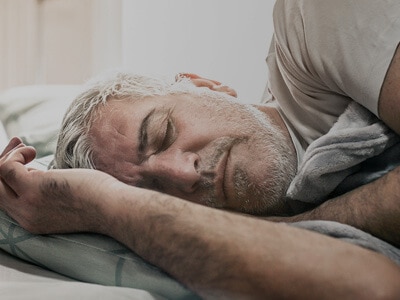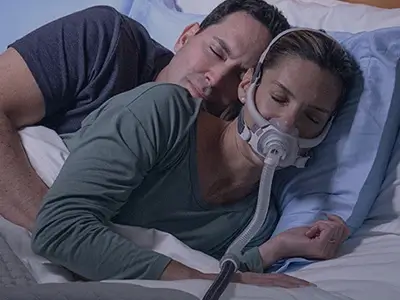What is sleep apnoea?
Sleep apnoea is a condition that means you stop breathing for short periods while you sleep.1 This prevents you from getting the healthy sleep you need to lead a refreshed, energetic life and can cause a number of other health problems. Although there’s no cure for this serious disorder, regular nightly treatment could improve your health and quality of life.2
What type of sleep apnoea?
There are several different types of sleep apnoea and they have different causes. Fortunately, they can all be treated.
- Obstructive sleep apnoea (OSA) occurs when the muscles and soft tissues of the throat relax during sleep and block the upper airway. It’s often accompanied by loud snoring or snorting. OSA is the most common type of sleep apnoea.3
- Central sleep apnoea (CSA) occurs when the brain stops sending signals to the breathing muscles during sleep. The airways remain open, but breathing stops. CSA is rarer than OSA.
- Mixed sleep apnoea is a combination of central and obstructive sleep apnoea.
- Cheyne-Stokes Respiration (CSR) is a condition that causes abnormal breathing during sleep (generally shallow breathing followed by deep breathing, with intermittent central apnoeas).4
All of these disorders are characterised by apnoeas and hypopnoeas.
An apnoea is where the muscles and soft tissues in the throat relax and collapse sufficiently to cause a total blockage of the airway that lasts for 10 seconds or more.
A hypopnoea is a partial blockage of the airway that results in an airflow reduction of greater than 50% for 10 seconds or more.5
You might also come across the term ‘sleep-disordered breathing (SDB)’. This term describes a variety of different nocturnal breathing disorders, including OSA, CSA, mixed sleep apnoea and CSR.
Who gets sleep apnoea and why?
It is important to remember anyone can have sleep apnoea – men, women and children. It is typically associated with:
- A narrow throat airway
- Being overweight/obese6
- Family history of sleep apnoea7
- Increasing age8
- Taking certain sedative medicines9
- Drinking alcohol10, particularly before going to sleep
- Smoking11
- Having certain physical characteristics.6
These include a narrow airway, a small lower jaw or large tonsils, adenoids or tongue, or nasal congestion caused by a deviated septum or nasal polyps. - Menopause
CSA and mixed sleep apnoea are often caused by medical conditions that affect the brainstem.

Starting your CPAP therapy at home
You’ve recently been diagnosed with sleep apnoea; we’re here to help you get started. Learn more about this therapy, including how to set up your equipment and monitor your results. You can also watch other CPAP users share their experiences.
Get your “What is sleep apnoea?” ebook...
Your free sleep apnoea ebook could help you to:
- Identify sleep apnoea symptoms
- Learn about sleep apnoea diagnosis
- Understand different sleep apnoea treatment options
Complete the form and we’ll send you a copy.
Please refer to the user guides for relevant information related to any warnings and precautions to be considered before and during use of the products.
References:
- D.J., Phenotypic approaches to obstructive sleep apnoea – New pathways for targeted therapy. Sleep Med Rev, 2018. 37: p. 45-59.
- Campos-Rodriguez, F., et al., Continuous Positive Airway Pressure Improves Quality of Life in Women with Obstructive Sleep Apnea. A Randomized Controlled Trial. Am J Respir Crit Care Med, 2016. 194(10): p. 1286-1294.
- Muza, R.T., Central sleep apnoea-a clinical review. J Thorac Dis, 2015. 7(5): p. 930-7.
- Eckert, D.J., et al., Central sleep apnea: Pathophysiology and treatment. Chest, 2007. 131(2): p. 595-607.
- Sleep-related breathing disorders in adults: recommendations for syndrome definition and measurement techniques in clinical research. The Report of an American Academy of Sleep Medicine Task Force. Sleep, 1999. 22(5): p. 667-89.
- Deacon, N.L., et al., Treatment of Obstructive Sleep Apnea. Prospects for Personalized Combined Modality Therapy. Ann Am Thorac Soc, 2016. 13(1): p. 101-8.
- Casale, M., et al., Obstructive sleep apnea syndrome: from phenotype to genetic basis. Curr Genomics, 2009. 10(2): p. 119-26.
- Ancoli-Israel, S., Sleep apnea in older adults–is it real and should age be the determining factor in the treatment decision matrix? Sleep Med Rev, 2007. 11(2): p. 83-5.
- Webster, L.R., et al., Sleep-disordered breathing and chronic opioid therapy. Pain Med, 2008. 9(4): p. 425-32
- Scanlan et al. Effect of moderate alcohol upon obstructive sleep apnoea. Eur Respir J. 2000; 16.
- Wetter, D.W. and T.B. Young, The relation between cigarette smoking and sleep disturbance. Prev Med, 1994. 23(3): p. 328-34.
- Wimms, A., et al., Obstructive Sleep Apnea in Women: Specific Issues and Interventions. Biomed Res Int, 2016. 2016: p. 1764837.








